Menus
- The European Grand Prix prototype
- 108 ° V4, 499 cc, 192 hp at 12,500 rpm, 129 kg
- Discovery
- In the saddle
- Test
- Conclusion
The European Grand Prix prototype
108 ° V4, 499 cc, 192 hp at 12,500 rpm, 129 kg
We find it normal to see Ducati, KTM and Aprilia currently competing in MotoGP to challenge the supremacy of the three Japanese MotoGP teams. And yet, you have to go back 25 years to see the last European 4-cylinder motorcycle fighting for victory, in the era of 2-stroke GP 500s.. A good opportunity to celebrate this 25th anniversary with the Elf 500 !
Subsequently renamed Suissauto, MuZ then Pulse by changing sponsorship, the ELF 500 of 1996 indeed marked the return to the motorcycle Grand Prix of the French oil giant, at the very moment when it announced its withdrawal from Formula 1 after 29 years, 128 victories and seven world titles acquired with Williams, Benetton & co.
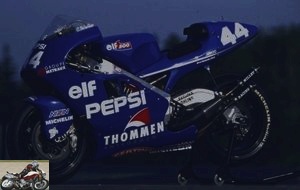 1996 Elf 500 test
1996 Elf 500 test
When the cash-strapped Italian Cagiva left the GP 500 at the end of the 1994 season, a big void formed. Even the Japanese manufacturers were convinced that the category badly needed a competitive 4-cylinder Made in Europe competitor to add a vital dimension to the grid, just as Ferrari has always done in Formula 1 against the British teams. But in 1996, the motorcycle finally appeared, thanks to a Franco-Swiss triumvirate comprising ELF (which paid the bills against the display of its name on the fairing), ROC (in charge of the chassis) and Swissauto (for the V4 engine). ). On his handlebars, we found the Spanish rider Juan Bautista Borja and the Swiss Adrian Bosshard starting the season on his handlebars, the latter being then replaced by the former British crossmen Chris Walker, only three years after his debut on the circuit. The ELF 500 was thus the Euro-racer par excellence. Only pistons and brakes were made in Japan !
Discovery
The heart of any motorcycle is its engine. And this is even truer in the case of the ELF 500, of which the wide-angle Swissauto V4 was the basis for the rest of the design. Yet while the engine seemed to follow the conventional route of Japanese productions, it was very far from being a Yamaha clone (like Cagiva’s). The ELF V4 indeed represented the European Grand Prix 500 method, innovative with its unique technique, although not nearly as radical as the series of ELF sports cars with steering hub and Honda engine of the previous decade..
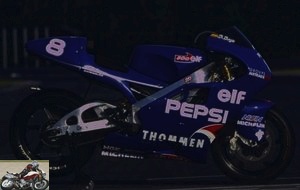 The Elf 500 marked the return of Europeans to GP
The Elf 500 marked the return of Europeans to GP
The Swiss-made reed valve, single crankshaft V4 was extremely light and compact. It weighed no less than 7kg less than a 37kg Yamaha YZR500 engine and was 130mm narrower than that of the Honda NSR500 and 100mm lower than the Yam. Unlike all other two-stroke four-cylinder engines, the ELF’s crankcases were split vertically to improve rigidity and above all to facilitate access to the engine. It was also a key factor in determining this cylinder opening at 108 ° to leave enough room for the four Dell’Orto carburettors..
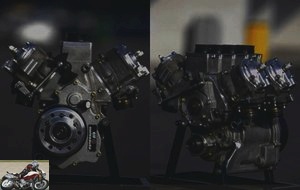 The V4 is distinguished by its wide angle of 108 °
The V4 is distinguished by its wide angle of 108 °
While everyone qualifies this engine as a V4, Urs Wenger, the boss of Swissauto, insisted on qualifying it as a "deformed boxer", due to the simultaneous operation of the opposing cylinders. A Bigbang version of the engine, at 90 ° was then produced by developing more power. The additional vibrations of this configuration, however, required the integration of a balance shaft. The internal configuration, lighter and more compact than that of Japanese engines, also made it possible to deliver an then impressive power of 192 horsepower at 12,500 rpm.
 The Elf delivered the trifle of 192 horses
The Elf delivered the trifle of 192 horses
On top of that, the 500 had a different ignition curve and power curve for each gear, which involved over a thousand adjustments to be made every weekend to optimize performance at each circuit..
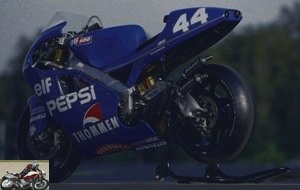 Telemetry had to be set every weekend
Telemetry had to be set every weekend
I had the change of driving the ELF 500 the day after the Czech Republic Grand Prix in Brno, during the first motorcycle GP season, in 1996. Having already ridden in Alain Michel’s sidecar with his 500cc Krauser engine, I knew this "V4" had a lot of power, but over a very limited range. And as the cynics of the paddock had previously cataloged the ELF motor as a simple modified side motor with an ultra low power range, I cannot deny that I was impatient to check this out for myself. Especially when Chris Walker assured me that his handling was at least as different as that of a Ducati V-Twin he had ridden earlier this year in the British Superbike..
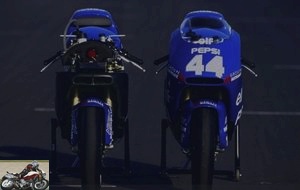 Many advertised the motorcycle as very difficult to ride
Many advertised the motorcycle as very difficult to ride
In the saddle
When I was able to take the handlebars of the bike the day after the race, I could see for myself that it was not what we thought of it. All of Swissauto’s hard work to smooth out its engine power for solo use had paid off well. She wasn’t docile – no such powerful motorcycle cut out to beat 130kg machines was – but she wasn’t the crash maker I expected either. The ELF was even much more progressive than the last 4 cylinders derived from a sidecar engine that I had driven, the Fior 500 in 1988. It’s funny, by the way, because it was French too..
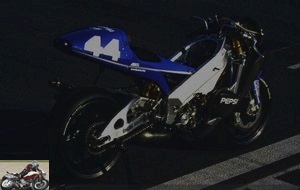 The ROC frame is very different from that of the Yamaha
The ROC frame is very different from that of the Yamaha
Despite the small size of its engine, the ELF’s ROC frame (quite different from the Yamaha frame made by the same company) offers a driving position reminiscent of the NSR with relatively low footrests that make it more comfortable for the great pilots. The result is that one feels like part of the motorcycle and can move around very easily..
Slide the weight of your body forward to prevent wheeling under strong acceleration out of a turn taken at medium speed, fall back behind the bubble to attack a straight line, return to the saddle with your arms straight on the brakes powerful to minimize weight transfer … It’s all very easy on the ELF.
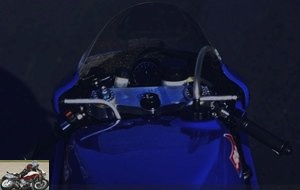 The Elf leaves room to move
The Elf leaves room to move
Test
The Elf is much more manageable thanks to its electronic management. You just have to be prepared for the surge of power that occurs as soon as you twist the grip above 10,000 revolutions. It’s just the fact of having so much horsepower available that makes the bike intimidating, not the way it delivers it. The Honda NSR500 is just as difficult to master, and although I haven’t driven the Suzuki RGV500 for a few years, I remember that it was more difficult. In fact, the Elf reminded me more of a Yamaha YZR500. It doesn’t go as high in revs as the Suzuki, but it does have some really huge torque and amazing mid-range power, with a relatively smooth transition to the maximum power zone..
The ELF starts to deliver good power from just over 8,000 rpm, but it’s only when the exhaust valve is fully open just below 10,000 rpm that it sends heavy. The power range therefore remains limited to around 3,000 rpm, a bit like the side. But the way electronics have streamlined the arrival of horses makes it more manageable.
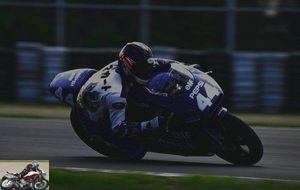 Power is truly impressive from 10,000 rpm
Power is truly impressive from 10,000 rpm
The curve flattens out around the power peak of 12,500 rpm. But while it is normally possible to push it a bit, it is apparently not advisable to overdo it, as the crankshaft does not like it especially since it was still under development when I had it. piloted.
If it is true that the vertical division of the casing facilitates the change of the vilo, the fact that there are less bearings than on the other GPs also implies a reduced lifespan to 1000 km, sometimes less. It was therefore common for the ELF team to change the crankshaft after each day of testing. Moreover, the one on my bike died shortly after my last session. Fortunately it was not me on board when the engine stalled! It was the Achilles heel of the bike at this point, not its too brutal power.
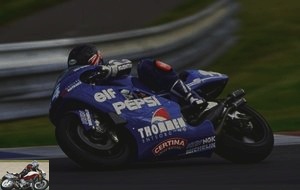 The crankshaft is very prone to breakage
The crankshaft is very prone to breakage
When I saw the Japanese carbon brakes mounted on the bike instead of the British or Italian calipers that Serge Rosset could have chosen, I admit that I was surprised. But that was until I tried it and found out why. In a way, these are the best carbon brakes I have tested in a decade since their introduction on the 1981 ELFe. Their massive stopping power makes it possible to achieve stopping distances much shorter than what I expected from carbon discs. And that by offering a feeling and a sensitivity close to the metal discs, allowing to reduce its speed in curve simply by slightly touching the lever rather than by squeezing hard. The best of both worlds, but we won’t talk about their cost !
The single crankshaft design had led me to expect the same kind of issues Honda encountered with the handling of the NSR, especially with this horsepower. But the combination of the ROC chassis, Ohlins suspension, and the small, lightweight reduced-inertia motor helps overcome that. In fact, the ELF’s strong point is entering a corner, especially if one uses the rear brake first to load the suspension and minimize mass transfer before applying the carbon brakes. The Elf remains well balanced and can be put on the corner almost as easily as the small Aprilia RSV400.
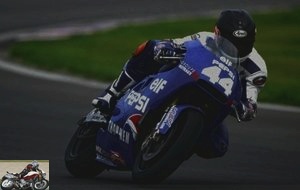 Carbon braking works ideally on the Elf
Carbon braking works ideally on the Elf
It also changes direction very well in the baffles, especially if you press hard on the rear brake just as you are about to shift from one angle to the other, to raise the bike..
It’s really well balanced, responsive without being jittery and straightening the Elf earlier out of a corner allows you to go harder on the throttle safely, so you can use the thick tread of the tire. to transmit all this power to the ground. When after a dozen laps at BRno, the 17-inch rear tire begins to wear out, you can feel the tire start under strong acceleration out of a corner, so it is important to straighten the bike before wringing the handle..
I noticed that straightening the Elf with the rear brake out of a corner allowed it to better cope with the acceleration and go harder. This was not only for the obvious reason of avoiding a highside by applying too much stress to the rear tire, but also because accelerating too hard on the angle pushes forward and understeers towards the outside the track. At first I thought it was because of my extra weight compared to Chris; So I asked the team to harden the rear shock. The Elf then behaved better, but with all the same a slight understeer.
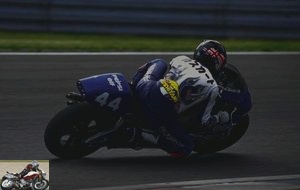 The motorcycle needs to be straightened out before re-accelerating.
The motorcycle needs to be straightened out before re-accelerating.
What seemed to be missing from the ELF at this point was the explosive acceleration I expected from a 500 V4- especially on a factory bike. The lap times showed that top speed was not an issue, even compared to the Japanese factory, but the brisk sequence of a slow turn to a middle turn in Brno was absent. Of course, the Elf 500 comes out of bends correctly, but it’s only when you’re halfway down one of the Brno straights that you really get a feel for the speed available, so that it is omnipresent on the Honda.
The temptation to get around the problem is to drive it like a 250, using a lower gear and roaring the engine, but that causes grip issues. At that time, there was no traction control and that made the front wheel jump, wasting time. The problem was not with the nature of the engine, but was probably related to the airflow. Personally, I am convinced that the large 39mm carburetors were involved. Much like the Cagiva of the day, the Elf was supercharged to achieve all that power in the towers. It is no coincidence that the Honda NSR only used 36mm carbs. And I’m sure the Elf would have gained in propulsion with smaller carburetors.
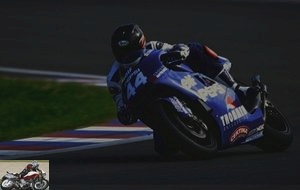 We blame this sportswoman for a lack of energy at the end of a curve approached at medium speed.
We blame this sportswoman for a lack of energy at the end of a curve approached at medium speed.
In addition, I really did not like the gearbox, offering a feeling of heaviness and a certain lack of precision. The Cagiva 500’s gear changes felt just as harsh to me every time I drove it, but at least a clutch lever was installed there to help counteract that. The Elf didn’t have one yet, during the debriefing I told Rosset that it should be a priority, because it would lower the lap times. Guess what he did !
Conclusion
The bottom line, having driven the Elf 500 towards the end of his first World Championship season, was that it was a project with a real future that already rewards the hard work that went into it. Thanks to the support of the French oil company, the European dimension was restored in 500 GP, bringing with it a breath of technical fresh air. It was not an alternative technology exercise in an attempt to be different, but a real contender for the GP places of honor who was progressing to come and play at the forefront. Having accomplished so much in the first season on the bike must have been very rewarding for the team. My ride to Brno on their new 500 showed they had a real competitor on the grid and subsequent events proved to be the case, albeit with another name on the fairing. !
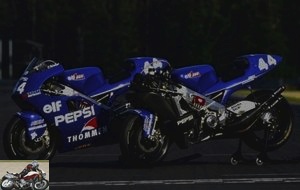 Elf 500
Elf 500
Strong points
- Braking
- Maximum power
- Maneuverability
Weak points
- Gearbox
- Backward acceleration
- Short power range
The 1996 ELF 500 technical sheet
Related articles
-
Sports test Chevallier Honda RS500
Against all odds V3 at 90 °, 499 cm3, 125 hp, 116 kg dry Beating the Japanese factory teams by winning Grand Prix with motorcycles you yourself built in…
-
Moto Guzzi 500 Bicilindrica sports test
The Methuselah of motorcycle racing 120 ° V-twin, 494 cc, 52 hp, 145 kg Birthday ! Moto Guzzi celebrates its 100th anniversary this year! In contrast to…
-
One of a kind V-Twin demodue, 904 cm3, 75 hp and 76 Nm, 186 kg dry, 2,000 copies produced You know you’ve been successful as a motorcycle designer when…
-
The first two-stroke of the Grands Prix 500 3-cylinder engine, 498 cm3, 82 hp and 59 Nm, 134 kg dry Ironic, really. Of the four Japanese manufacturers,…
-
Yamaha RZV 500R motorcycle test
GP 500 2 stroke … road ! 50 ° V4, 494 cc, 100 hp, 134 kg Sports bikers are familiar with the Yamaha RD 500 LC, inspired by Kenny Roberts’ YZR500….
-
Offenstadt Kawasaki 750 sports bike test
The H2 Monocoque Pilot-engineers are a rare breed, especially those who are equally expert in both disciplines and able to design innovative and unique…
-
Wayscral Hybrid Michelin electric bike VAE test
Electrically assisted bicycle with removable motor and battery via the Michelin e-drive system Urban mobility is advancing more and more quickly with an…
-
Dick Mann’s motorcycle victorious at the 1971 Daytona 200 The 200 miles of Daytona are one of the legendary races where talented riders on the handlebars…
-
The Japanese endurance Bimota based on Honda CBR900RR Fireblade 4 cylinders in line, 944 cm3, 177 hp, 163 kg TSR Honda AC90M. Who does this name mean?…
-
The last of the line The ultimate expression of ELF’s motorcycle design philosophy was the ELF5 , itself an evolution of the unsuccessful ELF4 and which…
What motorcycle does not heat up in the city ?! Otherwise, I find that its dressing is still not at the level of a V11 Coppa Italia, unfortunately!
> The Gone
well … no, I do not weight them.
And I confirm that the fork is only adjustable in rebound. And that this 1200 Sport 8v deserves better.
Both the quality and the height of the fork are penalizing to its handlebars for those who want to find Sport.
> RJVB
Admittedly, the heat released is felt more in town. But the Griso or the Stelvio, less streamlined, really seemed more pleasant on this point. Sport generates (dissipates less well) a lot of calories …